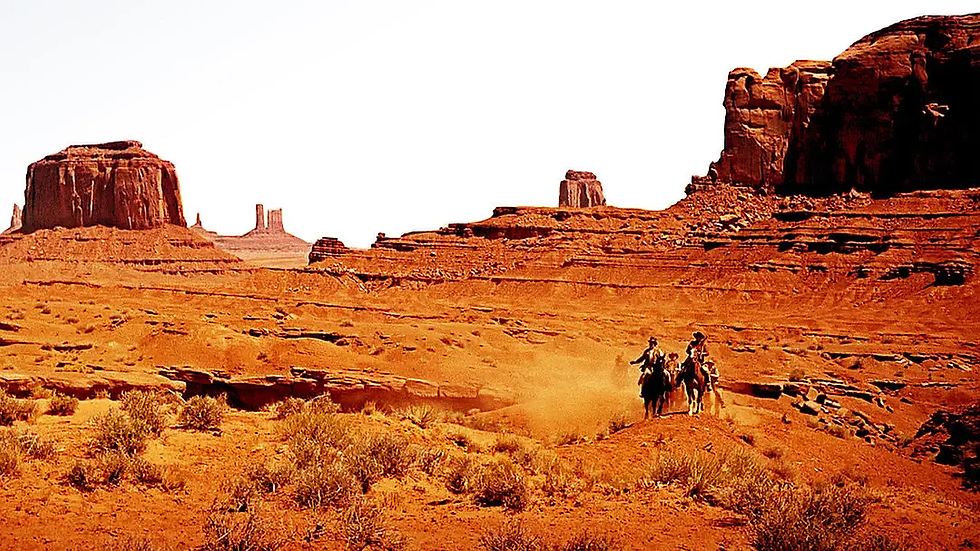春夏秋冬又一春 | 寒来暑往里的自观与救赎
- M

- Sep 22, 2020
- 6 min read
Updated: Jul 25, 2021
影片给了我很多关于佛教概念中“轮回共生”的思考,人与道德纪律之间的对抗,本能的爱,性和占有欲,向内的自观和自我救赎,以及如何通过景观体验表达人与物的联系。
随着一年里的四季轮回,小和尚对世界的认识也随着周期的季节变化而增长。"春之杀戒,夏之色戒,是因,秋之罪孽,是果。冬之修行,是救赎之道。又一春又是杀戒,是轮回。"从情节叙事的角度来看,春天象征着好奇心,青年的心态以及赤裸地对于探索世界的渴望的萌芽。当他无法用好奇心分辨是非时,他用石头将小鱼绑起来,在无意识的情况下犯下了恶,同时学习着与老和尚相处的方式。夏天是渴望的季节。与一个女孩的相遇激发了他人类本能的性冲动,于是像一场劫难一般,他面临着在人性与信仰约束之间寻求平衡的挑战。
随后的秋天是回归的季节。成为杀妻凶手的小和尚成年了,他无处承受苦难和来自外部现实社会的施压,爬上山顶,消耗体力极限的终日练习是他试图通过苦修获得自我救助的方式。在这个过程中,他探索到了佛陀在他心中的地位,心中有佛比手中有具象的佛更加重要。而冬天是顿悟和内心的沉淀,象征着佛教中的“空”;另一个春天的到来则象征着新生命,传承,轮回的开始,也暗示着导演对人类无法逃脱命运因果业力的一种深切关注。
在电影景观设置上,方的寺庙与圆形的湖面形成了一种哲学意味。同时镜头有着鲜明层次感,在动态和仍然不同的季节创造了流动和有节奏的四季风景,配以带有民族特征的配乐,金基德出色的视听语言给观者留下了深刻的印象。寺庙门口那道没有墙的门,就像是连接世俗和精神世界的过渡和分隔,使我想起了佛教里的基础观念:行为界限和自我约束。场景中央湖面中那座静谧的寺庙承载着四季的演替和变化,寺庙以船为唯一工具与外部世界相连,就像一个人的内心世界,我们以言语向外表达,在向内的自我和向外与社会的链接中周旋。
影片中同时运用了许多物体与动物的隐喻,寺庙和背景中山脉的孤寂感是老和尚平静内在的投射。在年轻的和尚经历了世界的跌宕锤炼,增长了年龄与阅历之后,老和尚几乎没有任何年龄变老的迹象。而湖水的意向象征着欲望和强迫。面对是否应该和女孩相爱的内心斗争时,年轻的和尚以游泳传递了他想要发泄内心欲望的冲动。在与女孩秘密地爬上山的路上,水随着他们的欲望的爆发而迸发。这是属于小和尚驾驭欲望的方式,激烈,冲动,炽热。而与之相对的是,老和尚知道如何带有控制地驾驭和控制水,永远不会轻易越过它,与水保持着距离。根据弗洛伊德的理论,蛇和水不仅代表欲望和罪恶,而且在另一面也象征着治愈和清醒。
船是我们与外界交流的渠道,佛像象征着对世界的理解和实现,而石头则象征着罪恶与救赎。由于乐趣和好奇心,他在小鱼和虾上放了一个石轭,最后,他经历了他曾对大自然和众生所犯下的恶,以重历同等的苦难而得到救赎。鸡和猫也是救赎年轻和尚的一种象征媒介。金基德似乎在向我们表明,欲望是人类的本能,我们一生的任务可能便是学会如何掌握它并与欲望求同存异地相处下去。
金基达的电影擅长表现人与自然的关系,通过电影场景和氛围来表达小人物的悲欢,他的表现力与电影中的哲学探讨超越了韩国的民族特色,经常能够激发关于人性和不可避免的因果论的讨论,展现了独特执导的才能。他的导演形式和技术,以及大胆激进的思考无法轻易地被模仿。人生是如此繁复,以至于金基德在导演时采用着一种不断简化提炼抽象的方法,从而能始终清醒地把握电影的内在主旋律。
正如勒罗伊·鲁纳(Leroy S. Rouner)在他的文章中所说:“世界上的所有事物都会以一种或另一种方式链接在一起。”小和尚在人生的各个季节中探索时,外界的事物和事物在他的脑海中留下痕迹和涟漪。经历了这些欲望和尘世间的挣扎之后,他才能洞悉现实中万事万物这种相互依存的关系,才能更清楚地了解人性的深刻并在菩提树下最终“涅槃”。这引导我们重新思考自然万物的力量。
2020 Spring LA 6940 中文为英文机翻
The filming gave me a lot of thinking about the Buddhist concept “codependent arising”, struggles between humanity and discipline, the instinct love, impulsion and possessiveness, reincarnation and redemption of heart, and how the self-nature in people and things are represented through landscape experiencing.
With the change of samsara throughout the year, the young monk's awareness of the world is also growing with a sense of cyclical time. From the perspective of the plot, in my understanding, spring is curiosity, youth mindset, and the bud of naked desire to explore the world. He tied the little fishes with stones when he could not tell right and wrong with curiosity, through that he was learning about the way to get along with nature and equality in the education of the old monk. Summer is the season of desire. The encounter with a girl releases the possessiveness of his human instinct, he was then facing the challenge to find a balance in the swing between human nature and the constraints of his faith.
Moreover, autumn is the season of return. The monk who became a wife-killer has nowhere to go with the suffering and the baptism of external reality, the long climbing to the top of the mountain to practice is his very ultimate way of self-salvation as a return. He then explored the Buddha in his heart is more important than its physical image. Winter is epiphany and precipitation of heart, symbolizing the “the field of emptiness” in Buddhism, another spring symbolizes a new life, inheritance, also shows the director's deep concerns towards the inability of human beings to escape karma and destiny.
As for the scenery with clear-cut layers, shots and crosscutting with contrast on dynamic and still in different seasons, soundtrack with ethnic characters, I was impressed by Kim’s great visual language. The door without a wall is like a transition and partition that connects the secular and spiritual worlds, which reminds me of the boundary of conduct or withdraw oneself in society in Buddhism. The quite lonely temple in the central lake withstands the changes of the four seasons, connecting with the outside world with the boat as the only tool, is exactly just like an individual's inner world with chances in our destiny.
Reckon on the metaphor of objects in the film, the constant solitude and intense stillness of the temple and mountains represent the indisputable peaceful mind of the old monk. He has hardly grown old in seasons while the young monk gone through ups and downs. The water of the lake signifies desire and compulsion. When facing the struggle of falling in love with the girl, the young monk vented his desire by swimming. On the way to the mountain with the girl secretly, the water rose with their desire bursting out. Instead, the old monk knew well how to control the distance with the water, would never easily cross it. The snake does not only represent desire and sin but also symbolizes healing and soberness according to Freud's theory.
The boat means the channel for us to communicate with the outside, the Buddha image symbolizes the understanding and realization of the world, while the stone is a double symbol of sin and redemption. He put a stone yoke on the little fish and shrimp because of fun and curiosity while in the end he is redeemed in the experiencing the suffering he made to nature and sentient beings. Chicken and cat are also a medium for redeeming young monk. Kim indicates us that desire is a human instinct, our lifetime mission may be to master and get along with the desire and disciple.
Kim Ki-dak's films have a special talented on representing the relationship between man and nature, misfortunes in ordinary people’s lives through movie set and atmosphere, his expressions surpass the national characteristics of South Korea into the discussion on human nature and inescapable causality, revealing unique boldness and thinking that cannot be easily imitated with his specialized form and technique. Life is so prosperous that it is ingenious for Kim to adopt the method of simplifying complexity and always soberly grasping the main theme from beginning to end.
As Leroy S. Rouner said in his article “All things that are in the world are linked together, one way or the other.” The external people and things leave traces and ripples in the young monk’s mind while he is exploring in life’s seasons. It is after experiencing these desires and earthly struggles that he can gain insight into this codependent arising and mutual relationship within the reality, can he see the background of human nature more clearly and realize the “essence” under the bodhi tree. This lets us convinced of the force of nature by virtue of which all things are gathered and brought into a relationship with one another.
Sofair, M. (2005). Spring, Summer, Fall, Winter... and Spring. Film Quarterly, 59(1), 36.
Parkes, G. (1997). The Place of Human in Nature: Paradigms of Ecological Thinking,
East and West. In Rouner, L. S. (Ed.), Is There a Human Nature? (pp. 149-171). University of Notre Dame Press.



Comments